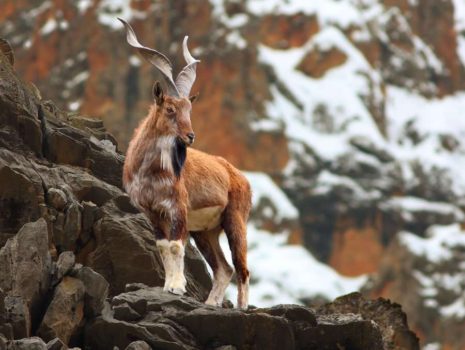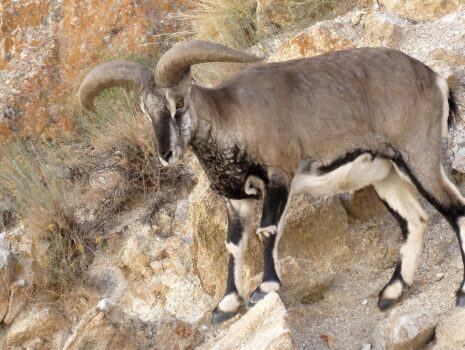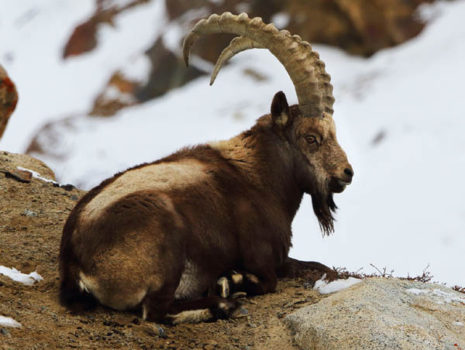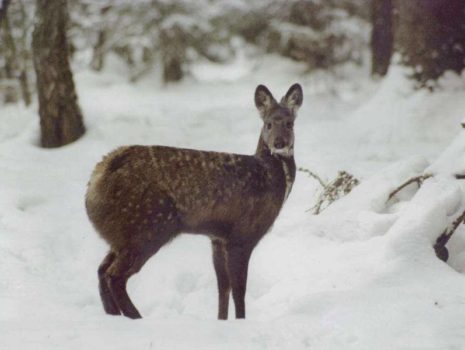
Literally, “Ungulate” refers to any animal with hooves, a hoof being an enlarged toenail. Important wild ungulates of Pakistan include Markhor, Urial, Ibex, Musk Deer, Blue Sheep, and Marco Polo Sheep. These are the main prey of the endangered snow leopard as well as a source of economic benefit for local communities who are engaged in sustainable trophy hunting. Proper monitoring is always deemed necessary by conservationists to measure conservation interventions as well as for the proper functioning of ecosystems. SLF is monitoring wild ungulate populations in its program sites using advanced methods, conducting research on ungulates’ various ecological aspects, and working with local communities to conserve them.
The Markhor is an endangered species of wild goat that is native to the mountainous regions of Western and Central Asia; it is found in Northeastern Afghanistan, Tajikistan, Uzbekistan, and Northern Pakistan particularly in Gilgit-Baltistan, Hunza-Nagar Valley and the disputed territory of Kashmir. The Markhor most commonly inhabits the high-altitude monsoon forests that litter these areas. The species typically inhabit scrub forests with oaks, pines and junipers, where there is plenty for the Markhor to eat. Markhors are well adapted to mountainous terrain and can be found between altitudes of 600 to 3,600 meters. Markhors are diurnal animals which means that they are most active during early mornings and late afternoons. The Markhor is an herbivorous animal that primarily grazes on grasses, leaves, herbs, fruits, and flowers. Markhors also play a valuable role within their eco-system by munching leaves from the low-lying trees and scrubs and then spreading the seeds…


The Blue Sheep, local name Bharal, has a bluish sheen in the coat and possesses distinctive horns that are ridged on the upper surface. Interestingly, the males have horns that grow upwards, turn sideways and curve backwards, looking somewhat like an upside-down mustache. However, females have horns that are much shorter and straighter. Bharal are active throughout the day, alternating between feeding and resting on the grassy mountain slopes. Due to their excellent camouflage and the absence of cover in their environment, Bharal remain motionless when approached. In Pakistan, the estimated population of the blue sheep is 1000 to 1500, present in Shimshal valley, Sakhtarabad nullah, Gojal areas, and Khunjerab National Park. Bharal are the favorite prey of the snow leopard and provide a significant prey base to the iconic species. The blue sheep are illegally hunted in most of its ranges. Therefore, detailed population assessment and conservation measures are…
The Ibex is a symbol of arid and rocky mountains of Karakoram, Hindukush, and Himalayas of Gilgit-Baltistan. The males have a heavy body and large horns while the females have a small body and small horns. Ibex’s presence in its natural habitat is essential to maintain a healthy ecosystem. In Pakistan, the Himalayan Ibex is found at a height of about 3,660 meters to over 5,000 meters in summer, whilst in the winter it can be seen below 2,135 meters during snowfall. The Himalayan Ibex is widespread in the higher mountain ranges of the Karakoram, Hindukush, and the Himalayan mountain ranges of Gilgit-Baltistan. Threats faced by the Himalayan Ibex include illegal hunting, human disturbance, habitat loss, and competition for forage with domestic livestock. However, the Ibex has a wider distribution, is plentiful, and its survival is not yet threatened in Pakistan. This is largely due to the inaccessibility of its…


The Musk deer is an endangered species native to Afghanistan, India, and Pakistan. Both sexes of the musk deer have prominent outstanding ears that assist it in detecting danger. The males possess a sizeable abdominal scent gland i.e., musk pod, the feature from which its name is derived. Musk deer is a solitary, territorial animal and inhabits small valleys between steep, inaccessible ridges that characterize its habitat at the upper limits of the tree line. In Pakistan, the musk deer is found at altitudes between 3000 to 4000 meters in Machiara and Neelum Valley of AJK, Indus Kohistan, Chitral, Astore, Chilas, and Gilgit. As a crepuscular animal, the musk deer remains active during dusk and dawn in search for food. This species of deer is the smallest of Himalayan ungulates living in the cold environment. Worryingly, the Himalayan Musk deer is listed as 'critically endangered' in Pakistan and 'endangered' globally.…